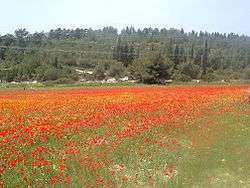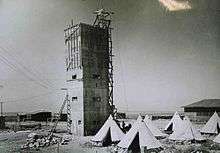Ein HaShofet
Ein HaShofet (Hebrew: עֵין הַשּׁוֹפֵט, lit. Spring of the Judge) is a kibbutz in northern Israel. Located in the Menashe Heights region around 30 km from the city of Haifa, close to Yokneam, it falls under the jurisdiction of Megiddo Regional Council. In 2019 it had a population of 861.[1]
Ein HaShofet עֵין הַשּׁוֹפֵט | |
|---|---|
 | |
 Ein HaShofet  Ein HaShofet | |
| Coordinates: 32°35′45″N 35°6′04″E | |
| Grid position | 160/222 PAL |
| Country | |
| District | Northern |
| Council | Megiddo |
| Affiliation | Kibbutz Movement |
| Founded | 5 July 1937 |
| Founded by | Hashomer Hatzair |
| Population (2019)[1] | 861 |
| Name meaning | Spring of the Judge |
| Website | www |
Ein HaShofet was established by two groups of Hashomer Hatzair graduates from Poland and Highland Mills, New York. They first settled the hill of Jo'ara in 1937 and later settled in the kibbutz' current location in 1938. "Ein HaShofet," literally, Judge's Spring, was named in honor of United States Supreme Court Justice Louis D. Brandeis (1856-1941), who played a leading role in the American Zionist movement.[2] There is a flowing spring nearby the kibbutz.[3]
The kibbutz owns three industrial companies which produce metal parts, mostly for vehicles, and lighting products on a global scale.
Geography
Ein HaShofet is located on the Menashe Heights, 5 kilometers south of the city of Yokneam Illit. Other places near Ein HaShofet include the kibbutzim of Ramat HaShofet, Dalia and the hill of Jo'ara. The kibbutz is accessed through the 6954 and 6953 roads, connected to Highway 66 and regional route 672.[2][4]
History
Prior to the establishment of the settlement
The founders of the kibbutz came from two groups. The first group was called "Banir" and consisted of Hashomer Hatzair graduates from Poland. The group formed in 1931 in Częstochowa and arrived to Mandatory Palestine in 1935. It received training in Ein HaHoresh. The other group also consisted of Hashomer Hatzair graduates from Highland Mills, New York. The group formed in 1922 and arrived to Mishmar HaEmek in 1931, where it received agricultural training.[5] Their number was 17 in 1931 and it rose to 30 in 1933. In 1934 they moved to Hadera.[6] In May 1934 both groups united in Hadera under the name "Banir-America" and worked together in the town.[5]
The initial location of the kibbutz was the hill of Jo'ara, about one kilometer from the current location of the kibbutz.[7] It was owned by an Effendi from a family called Salah, residing in Haifa, and was populated by Arab tenant farmers.[8] In 1936, the Jewish National Fund bought the land from the effendi and paid each sharecropper for their evacuation.[9] The funds for the deal were raised by Louis D. Brandeis, a United States Supreme Court Justice lawyer, and a prominent Zionist figure. The Americans donated 70,000 USD for the cause, with 50,000 coming from Brandeis himself.[10] The kibbutz was named in his honor.
Early years
.jpg)

On 5 July 1937 some of the members departed from Mishmar HaEmek, escorted by the Haganah, and arrived to the hill of Jo'ara. The kibbutz was established a part of the Tower and Stockade settlement drive.[11] Built on JNF land with the help of the Keren Hayesod company, it was the first Jewish settlement on the Menashe Heights.[7] Their departure was celebrated in Mishmar HaEmek, from where they brought dismantled structures, equipment for building a wall, and trees for planting. The climb was done on foot, as there was no paved road to the top of the hill. During the following winter the way to the hill was blocked and the members paved a new access road.[9]
The members stayed on the hill for one year before moving to the current and final location of the kibbutz.[5] They left the hill of Jo'ara after realizing it was too small. It was handed to the Haganah militia.[10] The construction of the first permanent building took place in June 1938[12] and in October the rest of the members from Hadera and Jo'ara joined the kibbutz in its final location. Many members joined the Haganah paramilitary organization and the Notrim Jewish police force.[5]
In 1945, Ein HaShofet had a population of 320, all Jews. It was noted that it was the village formerly named Ji'ara (i.e. Jo'ara).[13][14] Despite a lack of water and hilly difficult reclamation, in 1948, with a population of 450, they "were a successful mixed hill farm with orchards, dry cereals, dairy products, sheep herding and chicken farming."[15]
During the Jewish insurgency in Mandatory Palestine, Ein HaShofet housed a factory for explosives used by the Jewish militia against the British.[5]
During the 1948 Arab-Israeli war, the Ein HaShofet villagers helped to defeat Fawzi al-Qawuqji's forces after their April 1948 attack on Mishmar HaEmek.[15]
After the establishment of Israel
Until 1962, the kibbutz absorbed five other groups. Two of them were made of Holocaust survivors and the other are youth groups from Israel.[16]
Economy
The primary component of Ein HaShofet's economy is its industry with three working factories in the kibbutz. According to the 2008 national census,[17] 43% of the workers in the kibbutz in the industrial sector. The secondary component and historically the center of the kibbutz life is the agriculture, which employs 20 members of the kibbutz in five different sectors.[18]
Industry
The kibbutz owns three industrial companies through the Ein-Hashofet Industries Group.
- Mivrag Cold Forming Technology is a company that produces cold-formed steel components. In the local market, Mivrag supplies agriculture, industrial, high-tech and wholesale companies. In the worldwide market, Mivrag supplies automative companies.[19] With the establishment of the factory in 1952, Mivrag manufactured wooden screws. In the 1960s and 1970s the factory expanded to other products and moved to use metals. In 1987 the factory moved to its current facility. The company began to thrive since the 1990s, expanding its sales to Asia, North America and Europe.[20]
- Eltam is a company that produces lighting products.[21]
- MAG Ltd. (Mivrag Automative Group) was established in 1999 and produces assemblies for the automotive industry.[22]
Agriculture
- Dairy farming is the first agriculture sector of the kibbutz, beginning already in 1938 with the move to the kibbutz's current location. The dairy has over 200 dairy cows and produces trillions of litres of milk a year.
- Cattle farming began in the 1950s in order to exploit lands that couldn't be used for farming. The cattle sector is owned in partnership with kibbutz Mishmar HaEmek (Ein HaShofet owns about 70% of it). The sector struggles to exist due to low profits. In addition to cattle growing, the kibbutz has a successful cattle fattening facility.
- Orchards are today used for Avocado growing. The avocado growing began in the mid 1970s. In the early days of the kibbutz, plum trees were the main products. In the 1940s it were vineyards, followed by apples, peaches and pears in the 1950s.
- Poultry farming in the kibbutz is centered since 1971 on Chicken fattening.
- The field crops sector in the kibbutz is relatively small but profitable. It is centered on wheat and cotton.
References
- "Population in the Localities 2019" (XLS). Israel Central Bureau of Statistics. Retrieved 16 August 2020.
- About Ein HaShofet
- "Nahal HaShofet - Walking trails through Israel". www.kkl-jnf.org. Retrieved 2017-11-12.
- "About Ein HaShofet". Agriland.co.il (in Hebrew). 23 December 2014.
- "Ein HaShofet". Israel Labour Movement.
- Reinharz, Shulamit; A. Raider, Mark (2005). American Jewish Women and the Zionist Enterprise. University Press of New England. p. 206. ISBN 978-1-58465-439-1.
- Hareuveni, Imanuel (2010). Eretz Yisrael Lexicon. Ministry of Education. p. 744.
- "Tower, Stockade and a Kibbutz on the Jo'ara Hill". Ynet (in Hebrew). 15 July 2005.
- Rabad, Ahia (15 October 2016). "Jo'ara, The End: "They Taught a Squad Leader to Think Like a General"". Ynet (in Hebrew).
- Levi, Eyal (29 December 2017). ""ג'וערה הוא הווסט פוינט של המדינה, בושה שלא ממשיכים את המסורת" [Jo'ara is the "west point" of Israel, shame the tradition is not continued]". Ma'ariv.
- "History of the kibbutz (on the kibbutz website)".
- "The Cornerstones For the First Building In Ein HaShofet". Davar (in Hebrew). 9 June 1938.
- Department of Statistics, 1945, p. 13
- Government of Palestine, Department of Statistics. Village Statistics, April, 1945. Quoted in Hadawi, 1970, p. 47
- Jewish National Fund (1949). Jewish Villages in Israel. Jerusalem: Hamadpis Liphshitz Press. p. 37.
- Zakay, Zvi (27 July 1962). "25 Years for Ein HaShofet Settlement - Society Paths". Al HaMishmar (in Hebrew).
- "Population Census 2008 - EN HASHOFET" (PDF). Central Bureau of Statistics (Israel).
- "Agriculture". Ein HaShofet website.
- "Mivrag". Mivrag's Hebrew website.
- "History". Mivrag's Hebrew website.
- "Company Profile". Eltam's website.
- "MAG-EH - Products". MAG's website.